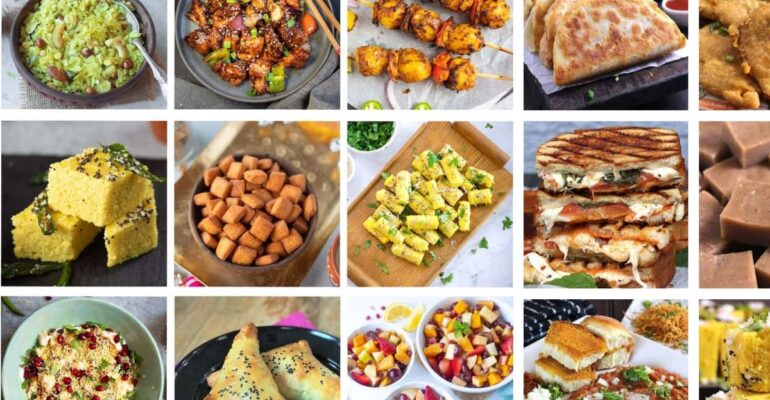Indian snacks – The magic of flavor
January 23, 2021 2022-11-11 5:05Indian snacks – The magic of flavor
A snack is a food generally eaten between meals and is smaller in portion size than major meals of the day. Snacks come in a variety of forms – fresh made at home, bought from street vendors or shops or as packaged food (Ready to eat such as chips, wafers, namkeens etc. or convenience foods such as frozen fries). These food items are usually portable, quick to eat and satisfying hence also termed as comfort food. They can be sweet, salty, sour and spicy. In Indian culture, it is hospitable to offer some snacks to guests with tea/coffee or other regional beverages.
Indian snacks:
Traditional Indian snacks are prepared with a vast variety of ingredients.
These include:
- Flour – Refined flour (Maida), wheat flour, rice flour, gram flour etc.
- Pulses – Green gram, Black gram etc.
- Vegetables – Potato, onion, brinjals, green chilies, green coriander, lemon etc.
- Flavorings agents – Coconut, Tamarind, Kokam etc.
- Spices & condiments – Salt (Table salt, Black salt etc.), chilli powder, turmeric powder, carom seeds, cumin seeds, mustard seeds, coriander powder, garam masala, chaat masala and a vast variety of spice blends.
- Nuts – Peanuts, Cashews etc.
The methods of cooking these snacks also vary from frying, steaming, roasting, sautéing, griddling etc. Many snacks have crossed regional boundaries and are relished all across the nation.
Regional classification of Indian snacks
NORTH ZONE
- Samosa – A conical shaped crust is prepared with refined flour dough. This is then filled with a spicy mixture of potatoes, sealed and deep-fried. Variations include variation in shape such as potli (bundle) samosa or a paper-thin crust such as in Bohri samosa. The filling may be cooked spiced mixture of pulse or even minced meat.
- Golgappe – Also popular as paani puri in west and phuchkas in east. They are made up of flour or semolina dough, rolled thin in small discs and deep fried so as to swell and make a thin crisp shell. This is then filled with a variety of ingredients such as boiled potatoes, boiled grams, filled with spiced water, chutney or even curd.
- Aloo tikki – A boiled potato based patty, spiced and may be stuffed with dal and shallow fried to a very crisp outer texture. It is served topped with curd, chutneys, grated radish and chana.
- Raj kachori – A crust similar to golgappa but larger in size filled with a vast variety of ingredients to give variety of textures and taste. There is boiled potato, curd, chutneys, spices, boondi, pomegranate seeds, boiled black grams, papdi, nylon sev etc.
- Kebabs – A variety of ingredients, coarsely minced and seasoned are skewered and cooked on charcoal grill or may even be griddled, shallow or deep fried.
- Tikkas – A variety of charcoal grilled snacks made from chunks of vegetables, paneer, meats of fish marinated, skewered and grilled.
- Namkeens: Rajasthan (Bikaner) is popular for various types of savories called namkeenthat form a popular tea- time snacks. The namkeens are made up of variety of toasted, fried or baked ingredients such as dal, potatoes, besan etc.
EAST ZONE
- Jhaal muri – Puffed rice mixed with many other titbits like peanuts, onion, tomato, boiled potato, green chillies, green coriander, mixture of spices and some mustard oil.
- Phuchka – Parallel to the golgappas of north, phuchkas are a popular street food in Bengal.
- Singhara – The samosas of the north are Singhara in west Bengal.
- Fuluri – Cauliflower florets coated with seasoned gram flour batter and deep fried in oil.
- Ghoogni – It is spiced chickpea or Bengal gram based curry enjoyed itself or served as a meal with hot puris.
- Fish kabiraji – Local fish fillet marinated, coated in beaten egg and breadcrumbs and pan- fried.
- Dimer devil – Boiled egg wrapped in spicy potato filling, coated with breadcrumbs and deep- fried.
WEST ZONE
- Batata vada – A popular potato snack recipe from Maharashtra, which is made by dipping, spiced potato balls in chickpea flour, batter and deep- fried. Batata vada is mostly served with chutney or sandwiched in a Pav.
- Pani puri – Parallel of the golgappas of the north.
- Bhel puri – A savoury snack made with puffed rice, tossed with vegetables and tangy chutneys. An essential ingredient of Bhel is sev, which are savory thin crunchy noodles, made of chickpea flour.
- Khakra – Round, very thin and crispy in texture, khakhras are commonly eaten in the morning with breakfast. They are made of wheat flour, oil and salt. There is a vast variety of khakras, a popular one being methi khakra.
- Dhokla – It is made with a fermented batter of rice and split chickpeas and is steamed. It is denser than khaman.
- Khaman – It is prepared with a fermented batter of gram flour with spices and steamed. It may be tempered and soaked in lemon sugar syrup. It is fluffier than dhokla.
- Bhakarwadi – It is a traditional Marathi cuisine sweet and spicy snack made from gram flour dough made into spirals stuffed with a mixture of coconut, poppy seeds and sesame seeds.
SOUTH ZONE
- Kuzhi Paniyaram – It can be served as a savoury or a sweet. It is made from black lentils, and rice and the preparation process is similar to that of an Idli but cooked on gas in a paniyaram chatti.
- Kothu Parotta – Parotta, made from flour, is a flat bread that is a typical household food in North. Kothu Parotta is made from shredded parotta, mixed with egg, meat or vegetables.
- Channa sundal – It is a south Indian recipe of a no onion no garlic stir fried chickpeas with spices and coconut. It is prepared during Vinayaka chaturthi or Janmashtami puja.
- Murukku – Murukku is typically made from rice and urad dal flour. The flours are mixed with water, salt, asafoetida and either sesame seeds or cumin seeds. The mix is kneaded into a dough, which is shaped into spiral or coil shapes either by hand or using a mould. The spirals are then deep fried in vegetable oil.
- Banana chips – Dried slices of banana, deep fried to a crisp texture.
Students enjoyed a range of different online activities and were positive about being able to access lecture recordings and participate live online.
Analysis of free text responses in the survey was particularly revealing and highlighted how being able to watch sessions again helped students to study in ways that better met their learning needs, improved their understanding and encouraged further independent study.
For instance, recordings enabled them to catch up if they missed the live session, manage the pace and take notes. They also made it easier for students for whom English is not a first language to hear and understand the lecture.
Some of the more engaging activities were less well used and there are opportunities to embed activities like the use of small group discussions for peer support and collaboration, quizzes or polls, and online research tasks into curriculum design, the survey found.







